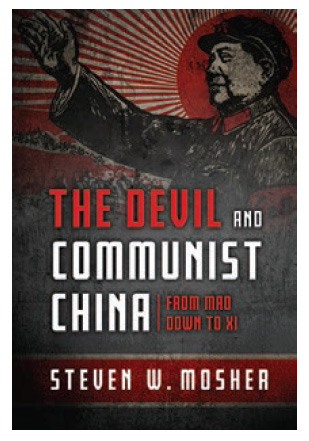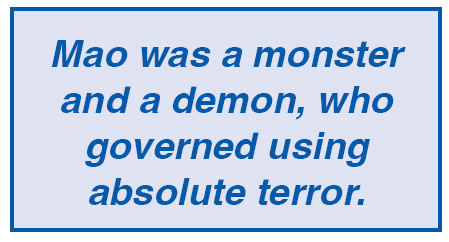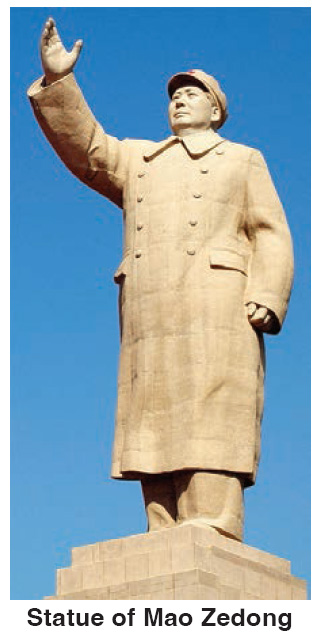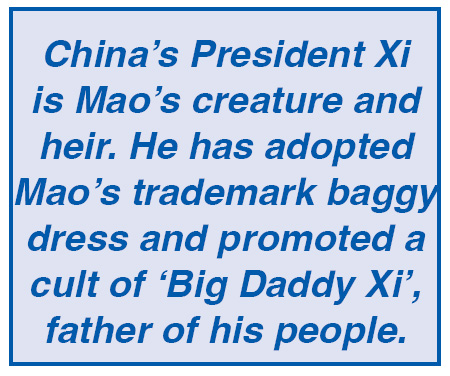BOOK SHELF Butcher laureate of the 20th century Book review by John Morrissey
The Devil and Communist China: From Mao Down to Xi, by Steven W. Mosher (Gastonia, North Carolina, USA: TAN Books, 2024). Foreword by Paul Kengor, PhD. Hardcover: 304 pages. ISBN: 9781505126501. RRP: US$29.95
 URL: Tanbooks.com
URL: Amazon.com
URL: Tanbooks.com
URL: Amazon.com
In his recent book, The Devil and Communist China: From Mao down to Xi, Steven Mosher argues that the regime known as the Chinese Communist Party (CCP) is the embodiment of evil — that at heart it is satanic, possessed of the Devil, known throughout history, whose existence only today is denied by so many. He explains that China has never known liberal rule from classical times to the present, and that the murderous oppressive rule under Mao Zedong is being perfected today under President Xi Jinping.
Steven Mosher is an American social scientist with expert knowledge on China, some of it gained while on a study visit in 1979, when he gained access to some government documents and witnessed the mass use of abortions forced on women under the regime's new "one-child" policy. His conversion from pro-choice atheist to pro-life Catholic was largely influenced by these experiences, although back in the U.S. his outspoken views on China thwarted his academic advancement. He is a prolific author and in 1989 he co-founded, with Fr Paul Marx, the Population Research Institute to counter the myth of global over-population.
He takes us first through the precepts of the founder of the Quin Dynasty several centuries before Christ, who, as Emperor Quin Shi Wang, "became the archetype of a political monster that has become all too common in our modern age". Absolute power over 40 million people was imposed by suppression of all voluntary associations, establishment of informer networks, punishments instead of rewards, use of executions to maintain the law and a strong army, and mutual surveillance with collective punishments. Called Legalists, a strong corps of civil servants with personal loyalty to Quin drove this regime.
Mosher calls Mao's "new vision for China", after the Communists seized power in 1949, "back to the future", for Quin Shi Wang was known to Mao then and Xi today from their studies of classical Chinese history.
Mao, in both his personal life and in the tens of millions of deaths his policies inflicted on the Chinese, is shown to be a monster and a demon, who governed using absolute terror.
He was shameless in his ingratitude towards his parents and his treatment of his first wife. A second wife was executed in 1930 and her children abandoned. A Soviet mental asylum was the reward for his third wife, while a fourth "suicided" after his death, when jailed for political activism.
One long-term liaison was with a dancer named Chen, which began when she was only 14. Countless numbers of innocent young country girls were procured to satisfy his lust and told that to be violated in this way was a "great honour". Many of his "tea girls" contracted venereal disease, which did not bother him. He convinced himself from Chinese medicine that his yang (male energy) merely needed much cooling influence from yin (female energy). Mosher rightly brands his carnality as statutory rape, practised on those who dared not refuse him.
 Mao showed not the slightest
regret for the murder and starvation
he deliberately inflicted on his
countrymen. He delighted in death
and destruction. In his own words:
"You'd better have less conscience.
Some of our comrades have too much mercy, not enough
brutality, which means that they are not so Marxist. On this
matter, we indeed have no conscience!"
Mao showed not the slightest
regret for the murder and starvation
he deliberately inflicted on his
countrymen. He delighted in death
and destruction. In his own words:
"You'd better have less conscience.
Some of our comrades have too much mercy, not enough
brutality, which means that they are not so Marxist. On this
matter, we indeed have no conscience!"
His first execution of a government official was a grisly public spectacle. In his military and political campaigns he employed torture and terror: "A revolution is not a dinner party or writing an essay, or painting a picture, or doing embroidery.… A revolution is an insurrection, an action of violence by which one class overthrows another."
Mao eliminated even rival Red Army commanders and units by betraying them to the Nationalists or committing them to hopeless engagements with the enemy, using the ancient Chinese military strategy "to kill with a borrowed knife". Later in Korea the waves of "volunteers" he sent to be slaughtered by U.S. troops were often units surrendered by Chiang Kai-shek's generals. In the wake of the Great Famine (1958–1962), initiated by the shambles of mass collectivisation, several of Mao's most loyal lieutenants who spoke out against the millions of deaths became victims during the Cultural Revolution (1966–1976). For sheer bloody treachery Mao was indeed diabolical, living out what Mosher calls the "anti-beatitudes".
It was not until 1989 when a senior official named Chen Yui defected to the U.S. that information from CCP archives on rural China was released to the world. It revealed a death toll of between 43 and 46 million, although some historians estimate the toll as closer to 60 million people. Mosher tells us of starving peasants reduced to cannibalism and of Red Guards during the Cultural Revolution who made it a ritual practice.
In the West, propaganda such as the monthly magazine China Today and that student favourite, nicknamed "Mao's Little Red Book", had painted a more benign picture. This reviewer can recall apparently educated people intoning that one can't make an omelette without breaking eggs! It was left to Jung Chang's bestseller, Wild Swans: Three Daughters of China, in 1991 to put flesh on the bones of these figures with her harrowing account of three generations of her family under the Communist revolution.
Further chapters reveal the theft of the wealth of China, from
the looting of revolutionary days to the confiscations which have
occurred up to the present, all behind the ascetic image of Mao
and others portrayed to the Chinese population and the world. As
Mao was a monster and a demon, who
governed using
absolute terror.
Mosher puts it, self-denial and sacrifice were for Mao's subjects,
his own life being one of perpetual, unrestrained indulgence.
There are also chapters on the spread of revolution across Asia,
including the murderous reign of Pol Pot in Cambodia from
1975 to 1979, where the excesses of China's Cultural Revolution
were repeated and even exceeded.
and a demon, who
governed using
absolute terror.
Mosher puts it, self-denial and sacrifice were for Mao's subjects,
his own life being one of perpetual, unrestrained indulgence.
There are also chapters on the spread of revolution across Asia,
including the murderous reign of Pol Pot in Cambodia from
1975 to 1979, where the excesses of China's Cultural Revolution
were repeated and even exceeded.
Mao died in 1976, but his immediate successors were just as committed to the iron rule of the CCP. Nowhere was this more evident than in the brutal prosecution of the one-child policy from 1981. It was imposed under Deng Xiaoping, seen as a moderate in the West as China's economy recovered, but who was the author of the bloody Tiananmen Square massacre in 1989 and the harsh crackdown on the Falun Gong from 1999.
Searching for a scapegoat for China's backward economy, the CCP adopted the flawed Western fear of over-population. "Reproduction must be planned," Mao had thundered, and in the Massachusetts Institute of Technology (MIT) computer modelling that underpinned the Club of Rome's 1972 report, The Limits to Growth, the Party found an alibi for the backwardness and stagnation which had followed Mao's revolution. Western "science" left them no choice.
What followed was propaganda and mass forced abortions and sterilisation of women. Mosher observed this at close quarters and his case study of a villager, Li Ahai, struggling to keep her baby illustrates the barbarous attempts of the CCP to punish her and all those around her.
His allusion to the account in Leviticus of sacrifice of children to the Canaan god Molech reinforces the central theme of this book that the Communist regime in China is truly diabolical. It was not until 2015 that Party leaders recognised that a shortage of marriageable women, an ageing population and a birthrate of 1.05 threatened economic growth and reversed this policy, without any compunction for what had gone before.
Aware that belief in God was incompatible with the totalitarian ambitions of Communism, Mao waged war on all religions. Christianity was most despised, as a Western influence, especially Catholicism, which is centred on a foreign state in Vatican City. There was a respite in persecution from 1979 to 2005, during which all Christian denominations attracted many millions of followers; but Mosher's focus is on relations between the Catholic Church and the CCP.
One of Mao's tools of control was the establishment of front organisations, in this case a Chinese Patriotic Catholic Association (CPA) in 1957. This resulted in an underground Catholic Church loyal to Rome and one which was state controlled.
When Mosher visited in the 1990s he was surprised to learn from the nuncio (papal ambassador) in Hong Kong that most of the laity and clergy in the patriotic church remained loyal to the Magisterium. He worked with those who were rebuilding churches and sheltering women from abortion and believes that the healing of the rift between the two branches of Catholicism was a bottom-up process undertaken with quiet support from Pope John Paul II.
 During the respite the issue of bishops had been solved by
the Pope consecrating both underground bishops and most
of those nominated by Beijing. However, an attempt by the
Vatican Secretary of State in 2005 to secure a formal written
agreement from the CCP disturbed
this informal understanding.
During the respite the issue of bishops had been solved by
the Pope consecrating both underground bishops and most
of those nominated by Beijing. However, an attempt by the
Vatican Secretary of State in 2005 to secure a formal written
agreement from the CCP disturbed
this informal understanding.
Xi Jinping's rise to power in late 2012 and the election of Pope Francis in 2013 were almost simultaneous. It was the efforts of the suspended homosexual predator Cardinal Theodore McCarrick in the role of negotiator with Beijing that provoked the CCP to investigate the domestic followers of this hostile foreign power. Mosher describes the religion of Communist China as a "national narcissism" that brooks no rivals. Its demand of the Vatican was that the Holy Father consecrate those patriotic bishops previously rejected and eliminate the underground church.
In 2018 new regulations stipulated that all religious sites must be registered, along with numerous restrictions, including prescribed reading of Xi's works in patriotic church services. A Sino-Vatican Agreement was signed that year which in practice meant that only bishops nominated by Beijing would be consecrated by Rome and the underground church abandoned, the sell-out that Hong Kong's Cardinal Joseph Zen had feared. There followed intense persecution of those in the underground church who did not join the patriotic association, with buildings destroyed and religious objects removed. To all these outcomes the Vatican seemed to turn a blind eye.
Mosher devotes a final chapter to Xi as Mao's "creature and heir", even in his revision of recent history. He has adopted Mao's trademark baggy dress and published his own speeches in a format identical to Mao's Selected Works. He is even promoting a cult of Big Daddy Xi, "father of his people".
The author observes that it is Communism itself with all its lies which is the "opium of the people", as Karl Marx called religion, used to "drug the masses into unthinking compliance". Xi is more powerful than any predecessor, being General Secretary of the CCP, chairman of the Military Commission and chairman of the People's Republic of China. This has swept away Deng's limits on tenure of more than two five-year terms as General Secretary.
The CCP system being notoriously corrupt, Xi used the pretext of an anti-corruption campaign to purge his political enemies and even allies, while appointing himself to chair numerous new bodies. Party Congress members all owe their positions to Xi's patronage, and the thoughts of his predecessors and even those of Marx, Lenin and Mao have "gone down the memory hole". Mosher expects him to die in office, as Mao did, a victim of megalomania and paranoia.
Of some comfort to the Western world, if not the Chinese people, is that Xi's regime may be sowing the seeds for its own downfall. Mosher reasons that, "since evil is ultimately self-defeating, Communism can never truly establish itself". Like that of every other Communist leader, Xi's rhetoric has predicted the demise of capitalism and victory of socialism, and he has even hinted at the ideal of expropriation of private property. Yet observers question whether he would be so foolish as to follow the socialist road to ruin, trod under the Soviets and Mao himself. Nevertheless, Mosher shows that Xi has been "killing off free enterprise in China — one billionaire at a time".
Initially, CCP leaders had employed a protection racket which shielded entrepreneurs from government scrutiny — for a price. However, Xi has decided that these too should be reined in, putting a watch on every non-state-owned company, with Party officials on their boards and a branch in their workforce. Wealth-creators became targets, and as Mosher puts it, officials found that the best way to eliminate capitalism was to eliminate the capitalists, with a little on the side for themselves.
Wealthy businessmen and women began to be charged with various crimes: the list begins with China's richest woman, Whitney Duan; then real estate mogul Ren Zhiquiang, who criticised Xi's handling of the pandemic; Sun Dawu, an agricultural mogul; and even China's wealthiest man, Jack Ma, who disappeared after publicly criticising the banking system. Disappearance, re-education, lengthy prison terms or execution have been the fate of those outside of the CCP's immediate control, even if it meant killing the goose that lays the golden eggs.
Mosher certainly shows that the Devil and Chinese Communism are a match made in hell, although he is not sufficiently presumptuous to consign Mao and Xi to damnation. By comparing the words of Mao and Xi with those of Scripture, the Catechism of the Catholic Church and the famous Bishop Fulton Sheen, he paints a stark contrast. However, The Devil and Communist China is such a valuable work that its explicit address to a Catholic audience is to be regretted. As a majority of China's upward of 70 million Christians are believed to be Evangelical Protestants suffering under the same afflictions as Catholics, we might have expected some attention to their outcomes under Xi also.
We are indebted to Steven Mosher for this detailed but very accessible work for those with only a sketchy knowledge of his subject. In hardcover, displaying a quirky turn of phrase and with an exhaustive bibliography of sources available in English, it is a welcome addition to any library.
John Morrissey is a retired secondary school teacher who has
taught in government, independent and Catholic schools. He
lives in the Melbourne suburb of Hawthorn with his blue
heeler, Tammy.
![]()
